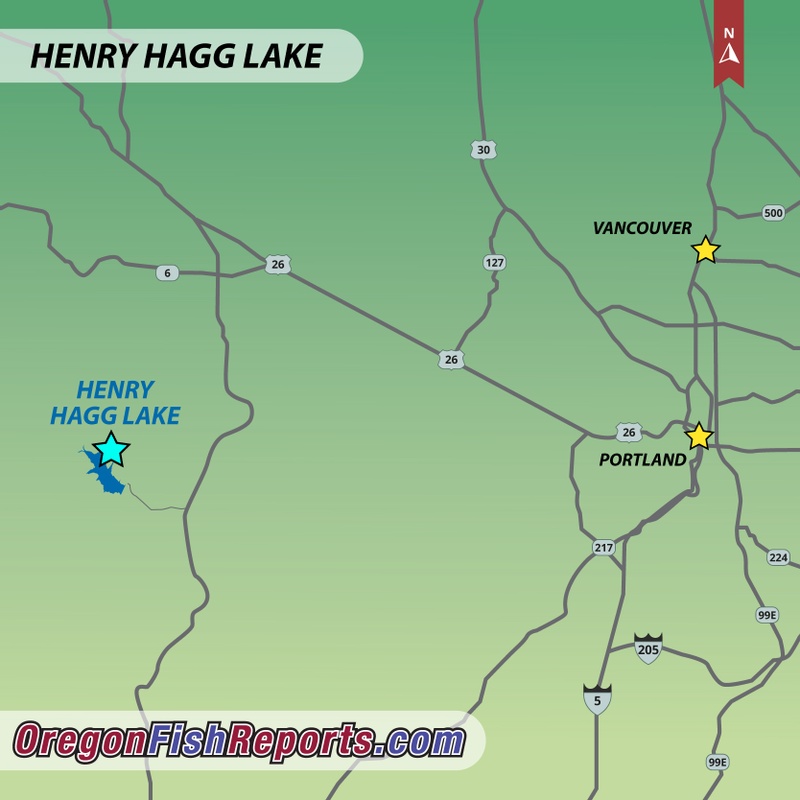Henry Hagg Lake Fish Report for 3-28-2024
Henry Hagg Fishing Report
Henry Hagg Lake - Gaston, OR (Washington County)

by OR Department of Fish & Wildlife Staff
3-28-2024
Website
Early springtime bass will be actively feeding and preparing to spawn when water temperatures reach 55-65 degrees. A variety of baits can entice strikes at many depths; hence a good rule of thumb is to start in deeper holding areas and work the travel corridors to spawning areas in shallower water until you locate them.
Main lake points tend to be more productive in between creek arms where they can feed, find deep water access, and be close to shallower spawning areas. Often the big females will shoal up in slightly deeper holding water behind the smaller schools of younger fish that feed up in the shallows. Once the water reaches 55 degrees start looking for fish in shallower depths when they really get into their spawning mode.
Crappie are following similar patterns as bass moving towards their spawning areas and feeding heavily. They'll be traveling the river channel ledges up towards the back of the creek arms. Anytime there is brush, logs or steep rocky type structure, they'll likely school nearby. Larger fish tend to be more solitary and slow trolling smaller crankbaits near the bottom can be productive.
Crappie deep water to shallow water migrations tends to be a little behind bass since they spawn in 65–70-degree temperatures. Just remember, structure is key for crappie, even if its random smallish boulders on the flats above their travel corridors.
Trout will likely be surface feeding on cloudy days until the water gets warmer and then they will hide below the thermocline on sunny days when the surface waters get above their temperature thresholds. This is when fishing baits suspended just over the bottom in harder substrate can shine when fishing from the bank.
When surface waters temperatures hit the 65 degree, trout may also be found where cooler creek water enters the lake. If the trout are in these areas, large trout imitation swimbaits can take the occasional bass over 5 pounds when conditions are right but be ready to be diligent and exercise patience.
Current reservoir level can be found here.
Hagg Lake is one of western Oregon's largest lakes and is a premier warmwater fishing destination. The lake is home to both the state record smallmouth bass and bullhead catfish.
Maintained and operated by Washington County, the park features numerous picnic areas, two boat launching facilities, more than 15 miles of hiking trails, and observation decks for wildlife and bird watching. The lake and lake park are currently open, although users are encouraged to check the Hagg Lake Park website, as conditions can change
More Reports
OR Department of Fish & Wildlife Reports
for Thursday, March 28th, 2024
Alsea River: The Alsea river has been fair the past few weeks
Kilchis River: The Kilchis is just starting to rise but should be fishable all week
Miami River: The Miami will be fishable all week, with Friday being the best conditions
Necanicum River: The Necanicum will be fishable all week
Nehalem River: It is just starting to rise and will likely get high and off color by Friday
Nestucca River: Winter steelhead fishing picked up the past week on the Nestucca
Siletz River: The Siletz has been remaining fair and steady throughout March
Siuslaw River: The Siuslaw is open for retention of hatchery winter steelhead
Three Rivers: Three Rivers should be fishable throughout the week
Trask River: The Trask River is on the rise and may get a little off color by Friday morning
Wilson River: The Wilson is on the rise and may get a little off color
Yaquina River: Winter steelhead will be entering the system
Detroit Reservoir: Reservoir levels continue to rise
OR Department of Fish & Wildlife Reports
for Thursday, March 21st, 2024Owyhee River - East Fork: Fishing should be fair just below the dam

Website Hosting and Design provided by TECK.net